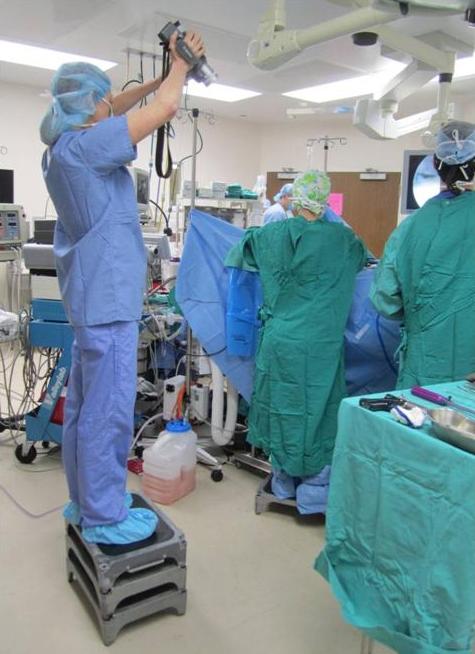Medical device manufacturers are increasingly aware of the need to conduct in-depth user research in the field (design ethnography) as part of the product requirements process. We work at a product development consultancy and conduct many of these studies each year on the behalf of clients. Sometimes, the goal is to better understand a surgical procedure to uncover areas for innovation; other times we are observing the use of a particular device to identify opportunities for improvement.
We have found that little information exists on what to expect when conducting user research in the OR. Although every hospital is different, here is some practical advice from our recent experience.
Getting into the OR
The first hurdle to overcome is gaining access to the OR and its staff. Unless you work in an organization that has hospital affiliations, it may be difficult to locate surgeons who are willing to participate. In our experience, there are three common routes:
1. The manufacturer identifies potential candidates through its sales force. If you work for a medical device manufacturer or are consulting for one, this is typically the easiest route. Sales reps have ongoing relationships with OR managers and surgeons, already have hospital access, are familiar with protocols and know the hospital layout.
2. The manufacturer provides a list of potential candidates. Sometimes our clients provide the names of surgeons they know and we contact them directly. In some cases this works well, if the doctors have been contacted ahead of time and indicated interest. But if not, it is very similar to cold calling.
3. Old-fashioned recruiting methods. This includes cold calling, advertising online and sending out flyers. We have found that doctors respond well to email and faxes, and offering a monetary incentive is standard practice. We usually work through their assistants.
Credentials
When you arrive at the hospital
If using one of the credentialing services, you’ll start by logging into the vendor’s kiosk and printing out your badge, and then check in with the front desk of the surgical unit. You may also be asked to sign a visitor’s sheet and/or a HIPAA agreement for patient privacy.
Once checked in, you will need to change into OR attire. This includes scrub top, scrub pants, hat, shoe covers, and mask. Your OR etiquette and blood-borne pathogens training comes in handy here. Avoid bringing valuables with you as there may not be a secure locker available.
Expect to wait around for a while. Sometimes surgeries don’t start at their appointed time for various reasons. Depending on the size of the operating room, hospital protocol and surgical team preference, you may be allowed in the OR during setup or asked to wait outside. Ask what you are able to bring into the OR (for example, a camera bag or briefcase). In general, bring as little as possible and only what you absolutely need.
 Taking photos and videos
Taking photos and videosIt is critical to document field research with photos and/or video, but this is a bigger challenge in the OR than in other environments. It is best to obtain permission from the institution and surgical team ahead of time, and we’ve found that surgeons in teaching hospitals generally are more used to people taking photos and videos. Make sure you are trained in patient confidentiality and refrain from taking photos of the patient and/or identifying information. In most cases, the surgical team must obtain patient consent that day, so remind them ahead of time.
OR etiquette
When you arrive in the OR, introduce yourself to the circulating nurse, offer your business card, sign in if necessary and explain why you’re there. Don’t assume that the circulating nurse and the rest of the OR staff know who you are or what you’re doing, because they may not have been told. Verify again that the surgeon and patient have given you permission to take photos and videos.
At the start of the case
- Know the roles of the OR personnel and act respectfully toward every member of the surgical team, regardless of his or her role.
- The safest bet is to stand up against the wall out of the way and wait for instructions. The circulating nurse or surgeon will point out a good place to stand.
- If you have a briefcase or camera bag, tuck it out of the way in a corner or behind you near the wall.
Sterility
- If it’s blue, don’t touch it or reach over it. It’s safe to assume that everything blue is sterile.
- Anything draped in clear plastic is also sterile (for example, the C-arm X-ray machine).
- Do not reach over or point over a sterile field for any reason.
- Never, under any circumstances, brush up against the surgical table, draped equipment or anyone sterile.
During the procedure
- If you move around to get a better view, do it slowly and carefully. Be mindful of tubes and cables, and stay away from any sterile areas or equipment.
- If a lead apron is not available, step out of the room when X-rays are taken, or stand behind a non-sterile person who is wearing one.
- Never eat or drink while in the OR.
- If you’re new to observing surgeries, certain parts of the procedure may bother you. Simply look away or focus on something else.
- If you are ever asked to leave, for whatever reason, do so immediately and bring your things with you.
Interacting with OR Staff
- Always ask if it’s OK to ask questions about what physicians or staff members are doing.
- Don’t take offense if the surgeon doesn’t talk to you during the procedure. He or she may offer commentary, but if not, save your questions for after the case.
- Don’t ask anesthesiologists questions until after the patient is intubated, the tube is secured and connected to the circuit and/or the anesthesiologist has sat down.
- OR staff will typically not talk to you during a case. They are trying to listen to what the surgeon says, and it’s hard to hear a mumbling doctor when they’re talking and listening to someone else.
After the case
- We almost always schedule time to interview the surgeon and/or other OR team members after the case. Expect to wait in the staff or physician’s lounge for a while following because there are lots of post-operative tasks to be done, such as transferring the patient to the recovery area, documenting the case, speaking with the patient’s family, etc. Use this time to review your notes and finalize your follow-up questions.
- Be mindful of the physician’s time and only ask the most important questions you need to. We typically have a set of pre-determined questions and then ask for clarification on what happened during the procedure. And of course, end the interview with a profound “thank you.”
Our final advice for conducting research in the OR is to be respectful, flexible, courteous, and professional. Always defer to the wishes of the OR staff, because the welfare of the patient and everyone’s safety are far more important than the data you’re collecting.







